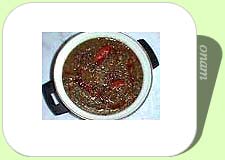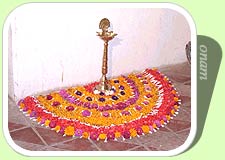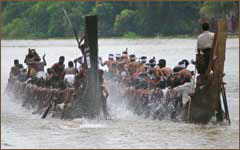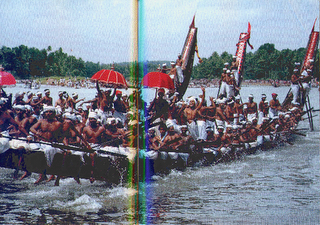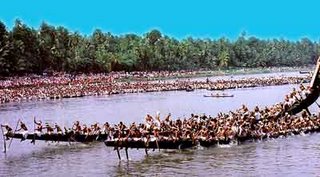Aranmula, Uthrattadi Vallamkali
Pathanamthitta district
The two day Aranmula Boat Race is more a water fiesta than a competition, conducted during Onam. The event is a re-enacting of the legend involving a devout Brahmin who made a votive offering of feeding one pilgrim a day. One day Sree Krishna himself appeared to him and the overjoyed Brahmin vowed to offer 51 measures of rice and all the provision for the thiruvona sadya (the sumptuous Onam feast) at the Aranmula Parthasarathy* Temple. Once, the thiruvonachilavu thoni (the boat carrying the offerings) was intercepted by rivals from another village, but the Brahmin's own villagers came to the rescue on snake boats. From then on the offering was carried by a fleet of palliyodam - about 48 of them representing the nearby backwater villages. (A palliyodam is a large, luxurious snake boat used by gods and royalty.)
Today, only 26 snake boats participate in the event which is marked by a colourful water carnival - an imposing effigy of Sree Krishna is taken out in procession on the lake with children dressed as nymphs and princesses. On the second day, snake boats decorated with silken parasols, carrying helmsmen, oarsmen and singers assemble near the temple early in the morning and then move away in pairs, creating a magnificent pageant. The boat race proper is held in the afternoon.
* Parthasarathy is Sree Krishna
in his role as Prince Arjuna's charioteer, in the epic Mahabharatha.
Champakulam Moolam Boat Race
Champakulam, Alappuzha
The oldest and most popular snake boat race in Kerala, this event is closely connected to the Sree Krishna Temple at Ambalappuzha. The race is held on the Champakulam Lake on the moolam day of the Malayalam month midhunam, the day of the installation of the deity at the Temple.
Legends say that Maharaja Devanarayana of Chempakasseri, as instructed by the royal priest, built a temple at Ambalappuzha. But just before the installation of the deity he was informed that the idol was not auspicious. The king was disturbed, but his minister suggested an inspired solution. To bring down the beautiful idol of Sree Krishna - presented to Arjuna by the Lord himself, from the Karikulam temple in Kurichi. The minister with a few others went to Kurichi, met the authorities there and returned with the idol. On the way back they stopped at Champakulam to spent the night and perform a pooja. The next morning boats from the entire region assembled to escort the idol in a colourful, ceremonial procession through the lake to the Temple.
Years later the pageant is still re-enacted with the same enthusiasm. An exotic procession of water floats, boats decorated with colourful parasols and performing arts greets the spectator before the race. The race proper is held in various stages for various categories of boats.
Payippad Jalotsavam
Alappuzha
The three day annual fiesta on the Payippad Lake, 35 km from Alappuzha, commemorates the installation of the deity at the Subramanya Swamy Temple, Haripad. The story is that the people of the village decided to build a temple with Sree Ayyappa as the presiding deity. After the temple was ready, they had a vision directing them to a whirlpool in Kayamkulam Lake where they would find the idol of Sree Subramanya which was to be installed at the temple. Accordingly, the elders of the village with divers and swimmers rowed to the spot and found the idol which was escorted back ceremoniously by devotees from the entire region in colourfully
Other boat races held during Onam (August/September):
ATDC Boat Race, Alappuzha
Rajiv Gandhi Boat Race, Pulinkunnu
Neerettupuram Boat Race
Kumarakom Boat Race
Karuvatta Boat Race
Kavanattinkara Boat Race,
Kumarakom Arpookara Vanitha Jalamela,
Kottayam Mahatma Boat Race, Mannar
Thazhathangadi Boat Race,Kottayam
Kottapuram Boat Race,
Kodungallur and Kumaranasan Smaraka Jalotsavam, Pallana.
The Indira Gandhi Boat Race is held on the Ernakulam Lake during the Cochin Carnival in the last week of December.
